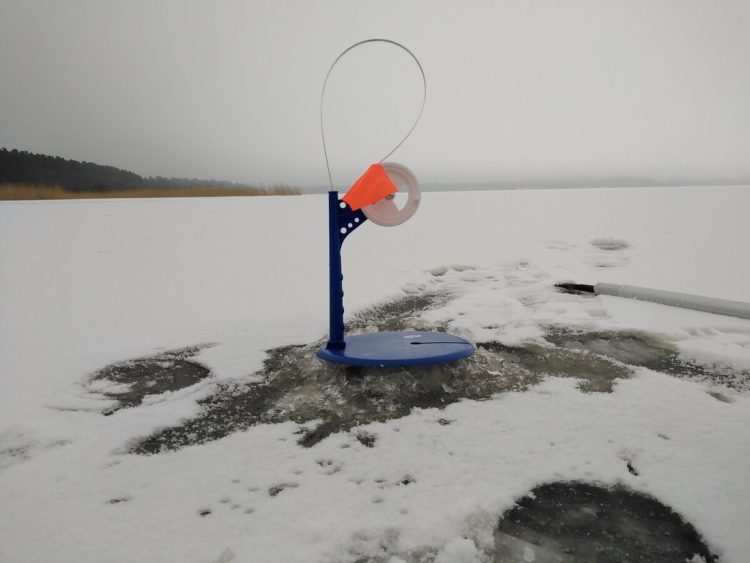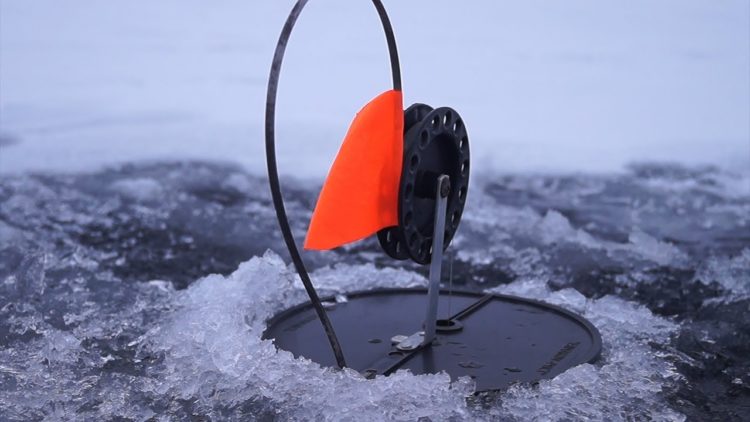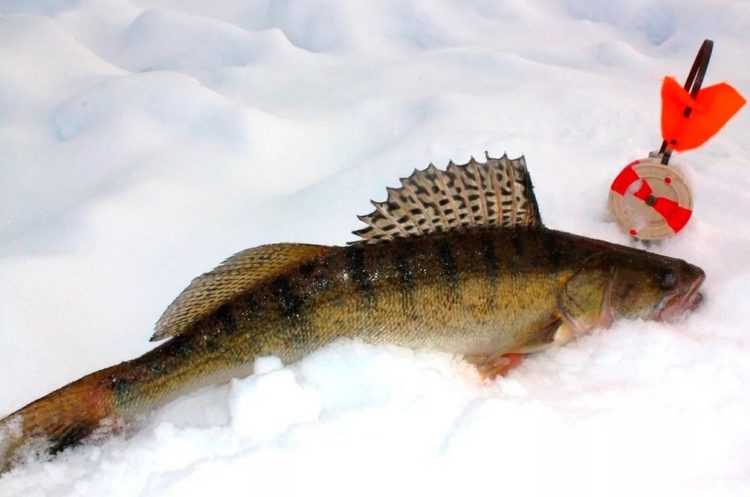Contents
For true predatory fish hunters, the fishing season never ends. During the freeze-up period, the choice among underwater inhabitants is not so great, however, with skill and desire, you can practice catching perch, pike and, of course, zander. The fanged inhabitant of the depths bites perfectly from the ice, if you choose the right fishing area and tackle. In addition to sheer lures, pike perch can be successfully caught on a bait equipped with live fish.
The design of the pike perch
At the moment, the market provides many different models that differ both in price and in basic characteristics.
When choosing a vent, it is important to take into account several parameters of gear:
- material of manufacture;
- rack mounting method;
- the shape and diameter of the base;
- the height of the rack and flag;
- reel width;
- the presence of a stopper and an adjusting bolt.
Most often purchased models are made of plastic. Budget products contain the most common plastic, which freezes in the cold and can burst with a light touch on the ice. Such gear should be avoided, because as the famous proverb says: “The miser pays twice.”
If the budget does not allow you to equip high-quality vents, you can consider other options. Homemade gear is made of wood in combination with plastic or spring, and thin plywood is also used for the base. The price of such devices is much lower than the market value, they are durable, although sometimes not the most comfortable.

The method of fastening the rack of the girders is one of the important nuances of durable gear. When fishing in extreme conditions, many designs fail when the angler cannot secure the flag. The simpler the fixation of the rack, the more reliable the vent.
To catch pike perch with vents, you need to take care of the stock of fishing line, since fishing is carried out at depths of 6-7 m.
The base can be of any shape: square, round, rectangular, etc. When fishing for walleye, it doesn’t matter if the platform covers the hole, because sunlight does not reach the depth where the live bait is. However, for greater comfort, you need to select a vent that completely closes the hole in the ice. This will help prevent the hole from freezing, and the platform will also prevent the snowdrift from falling down if the vent needs to be dug in.
The flag is attached in two ways: on the rack and to the platform. In the first case, it always remains in working order, even if the hole is littered with snow. A high flag is better seen from afar, so the best option for a vent is with a flag attached to a high rack. Mounting the signaling device to the base reduces the possibilities of the design. In severe frost, the vents have to be covered with snow along with the flag. Thus, when biting, it may not work.
Wide spools quickly wind out the line, and this is important when placing and removing vents at great depths. Reel clamps and bolts are needed to adjust free play. As in the case of pike fishing, the zherlitsa needs to be improved so as not to drop the loops when the predator moves sharply. An unadjusted reel causes fish to come off in 50% of cases.
How to choose a zherlitsa for zander
It is worth noting that ready-made tackle assembly should not be bought. As a rule, they are equipped with the cheapest non-specialized fishing line in small quantities, weak leashes and hooks.
You need to choose tackle according to your own budget. When checking the vent, you need to make sure that it is intact. Factory designs do not hold the flag on the coil, so it needs to be folded a little.
On public water bodies, the allowed number of vents per person is 5 pieces. It is impossible to exceed this norm for two reasons: administrative punishment and a fine, as well as universal fishing principles.
Quality gear must meet the following requirements:
- rack height for comfortable fishing;
- reliable fastening;
- structural integrity;
- absence of defects and chips;
- glued flag.
In the center of the platform there is a hole for threading the fishing line, as well as a slot that is not cut to the end. Experienced anglers recommend not to break the slot so that the bell design is more assembled.

Photo: www.zakruti.com
After the purchase, you need to look at the tackle again, adjust the free play of the reel, and make sure that everything is in working order.
Most predator hunters do not pay enough attention to the transportation of gear, so they often break. One of the most common breakdowns is a chipped reel. Of course, such gear remains working, but the appearance spoils the pleasure you get from fishing.
It is necessary to store tackle in a disassembled state in a special bag. Today, the fishing market makes it possible to pick up transport backpacks and bags with compartments for platforms, flags and racks with reels. There is enough space in the transport inventory to store and transport 5 girders.
Pike perch equipment
To make the tackle effective and durable, you need to assemble the installation with your own hands. First of all, you need a fishing line with a cross section of 0,35 mm. This diameter is enough to catch a predator weighing up to 5-6 kg. As a rule, fishermen often come across individuals in the region of 0,5-1,5 kg, and specimens that have reached a mass of more than 3 kg are considered trophies.
A soft winter line with high stretch and abrasion resistance is best. For catching pike perch on a zherlitsa, it is necessary to select transparent nylon or a fishing line with a bluish tint.
For mounting on a pike perch you will need:
- lead sinker of sliding type;
- silicone stopper;
- thick fluorocarbon leash;
- metal clasp;
- double or single hook.
The load is set at a distance of 30-40 cm from the bait, fixed with a stopper only from the bottom side. When biting, the pike perch grabs the prey, the flag is triggered, and the sinker falls to the bottom. Live bait is set above the bottom, in 3-4 turns of the coil.
The leash is tied directly to the line. Its length of 50 cm is sufficient, the diameter of fluorocarbon varies in the range of 0,5-0,6 mm. In places where pike is mixed with pike perch, metal twisting, titanium or tungsten are used. The latter option spins a lot, so the tungsten leash must be changed after each catch.

Photo: sazanya-bukhta.ru
You can store the equipment directly on the vent, removing the hooks so that they do not cling to neighboring gear. A fishing line with a sinker and a leash is wound on a reel, after which it is fixed with the help of stationery gum. Some designs have a special eyelet for the fastener, but if it is not there, you can get by with improvised means.
The hook is not directly tied; for its installation to the leash, an “American” clasp is used. Since the live bait is often hooked under the gills, all the metal elements are hidden inside the bait. Hooks use single and double.
When buying them, you should pay attention to several features:
- the size;
- forearm height;
- the presence of notches;
- sharpening type;
- color and material;
- value and brand.
For catching zander, it is recommended to use medium hooks No. 2-4. It is harder for the tee to break through the hard mouth of pike perch, so it is left for other types of fishing. Long hooks are preferred as they are easier to remove in cold weather. Products with mechanical sharpening can be sharpened during fishing, if the hooks were sharpened with a diamond type, then they cannot be resharpened.
By the color of the hooks, you can determine the material from which they are made. The most budget products can have thick wire and a light gray tint. They unbend much faster than models of a dark metallic shade. Forged hooks are not currently found, usually cast products can be found in packs.
How to arrange the vents to catch the “fanged”
Getting to a new body of water or an uncharted area of an already known water area, it is necessary to go to the desired depth. Pike perch stays in the pits in winter and practically does not leave them. The fanged robber can be found in most cases near the bottom, so they are fishing there.
Promising places for fishing in winter:
- riverbed;
- pits, exits and dumps;
- rocky and shell ridges;
- channel edges and drops.
Pike perch chooses shelters according to several principles: the presence of ambushes, food supply and oxygen in the water. If there is no current in a deep hole, silt can stagnate there and increase the level of nitrates. Fish usually leave such places, moving to wintering flow holes.
The predator does not stand on the rapids, but it is often caught in the middle course. Heaps of snags, logs or stones attract packs of fanged robber. During the freezing period, the predator stays in large groups, so the triggered vent cannot be moved to another hole. A flock consists of individuals of the same size, but in rare exceptions it may contain fish of different masses.

Photo: sazanya-bukhta.ru
Pike perch has sharp eyesight, so shiny lead sinkers should be put in a box and forgotten about for several months. For fishing use only matte lead, patinated.
It is necessary to set gear on an unfamiliar body of water widely, but within sight from the center. The first vent is installed on a dump, then they move relative to the relief. Every elevation or depth difference must be taken into account. Walleye often stays close to bream, so anglers with stationary rods on the ice are a good guide.
At the beginning of winter, pike perch is active, so vents can be left in one zone for a long time. When ice builds up and the oxygen balance changes, the fish become less mobile and have to move around the reservoir.
A wide arrangement of gear allows you to determine the location of the “fanged”. During the freeze-up period, pike perch stands locally, so other gear can be rearranged to the triggered vent.
If there are no signs of fish on the pit, it is necessary to move to smaller zones. Exits, rocky slopes and shelly edges attract the “fanged one”, in such areas it lingers for a long time.
On the rivers it is necessary to look for any relief changes:
- deep edges;
- hills and pits;
- fluctuations in the riverbed;
- sand bars.
Fish can camp in one zone, but feed in neighboring areas with relative shallow water. Hills attract whitefish and perch, followed by a larger predator.
On ponds and lakes, the search for zander begins with the deepest places that have been found. An echo sounder will help you find promising areas of the water area. It is important that the device is specialized for winter fishing and works in extremely low temperatures.
At the moment, small round-shaped devices that can be paired with a telephone are very popular. The echo sounder works through a special application in which you can track the depth, relief, change in the horizon of the live bait, as well as fish.
Searching for a predator using an echo sounder is a thankless task. Experienced anglers do not pay attention to the fish, reading information about the depth and relief. Another useful function of the echo sounder is the ready-made depth map. Many models provide such features in a free version or in a PRO subscription. Having a relief map of the bottom of the reservoir, you can quickly go to a promising point.
The subtleties of fishing on the zherlitsa
Pike perch attacks prey from the head. The mouth of a narrow diameter does not allow turning the fish as quickly as the pike does. In addition, the “fanged” selects prey with a narrow body structure, which he can swallow.
Sometimes the instincts of a predator and a hungry winter force them to pounce on a scavenger, but the pike perch cannot do anything with it, so the fish leaves with characteristic marks from fangs. If beaten prey comes across in the bream fishing zone, it means that somewhere nearby there is a flock of zander.
When biting, you should not rush to the vent. Despite the great depth of fishing, the quick steps of the angler on the ice are still clearly audible under water. When biting, it is necessary to give the predator time to swallow the prey. For pike perch, this process takes more time than for pike. After a bite, the predator may remain under the hole or wind the coil a little. After the first winding, it is impossible to hook. First, the fish moves away, swallows the live bait, and then moves on.

Photo: Yandex Zen channel “Severyanin”
The hooking follows at the moment of the second scrolling of the coil, when the predator moves away from the gear. If hooking during a pause, you can pull the hook right out of your mouth.
Rules for competent catching pike perch on zherlitsy:
- Gear must be placed in such a way that when approaching them, the reel is clearly visible. That is, the zherlitsa should stand sideways to the angler.
- It is important to consider the strength of the wind. When fishing in strong winds, tackle can be blown off the hole, so it must be directed vertically with respect to air currents.
- When biting, do not rush. Large pike perch takes more confidently, a lot of idle poking indicates small prey in the fishing area.
- You can not pull the fish impudently. Raising pike perch from a great depth, the pressure of the fish does not have time to stabilize, which is why many small individuals emerge to the holes with bulging eyes. Such a fish is a non-resident, you will not let it go. At the moment of fighting, it is important to pull yourself together, overcome the excitement and let the zander slowly rise from the depth, especially if the resistance is weak.
- It is also necessary to lower the live bait smoothly so that the swim bladder is deflated in the fish. If you throw a live bait with a large load, it may not survive the delivery to the bottom. In this case, they are already fishing for a dead fish, to which the fanged robber sometimes also responds.
If a loop has somehow appeared on the coil, it should be hooked immediately. A loop thrown over the reel stops the fish, and it can either cut off the tackle or spit out the bait.
When catching zander, you can stumble upon a good bite. Anglers popularly call this phenomenon “distribution”. Once on such a fishing trip, it is important to act according to fishing principles and not exceed the allowable catch rate for zander.










